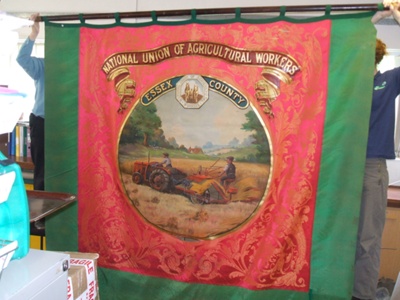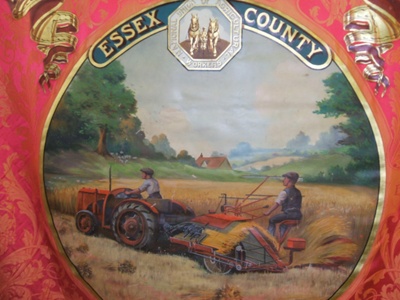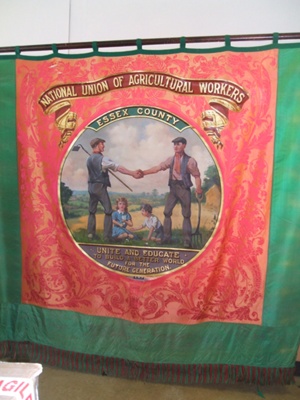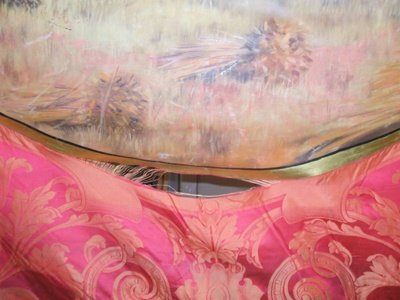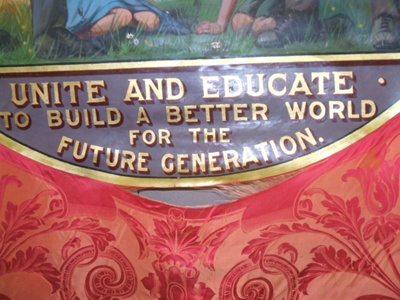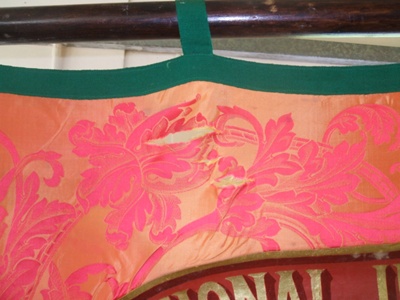Name/TitleBanner
About this objectA marching banner which was made for 'The National Union of Agricultural Workers- Essex County'.
One side shows a picture of a tractor (ICE), with driver, drawing a reaper binder, with operator, cutting and binding corn in a cornfield. The tractor appears to be of second world war vintage. The whole scene is set in a medallion with the words 'Essex County' at the apex either side of an octagon in which a pair of horses harnessed to a vehicle with the words 'National Union of Agricultural workers' around the rim of the octagon. Right across the entire top of the banner in a scroll are the words 'National Union of Agricultural Workers'.
The other side also had a similar set up with the scroll across the top. In this case the picture in the medallion is of two men, dressed as farm workers, clasping hands in a handshake and the one on the left has a hoe over his left shoulder and the one on the right is holding a fork which is resting on the ground. Between them are two children, the girl on the left, kneeling and holding a kitten (?) in her arms and the boy on the right kneeling and leaning towards the girl with one hand outstretched.
In this case the words 'Essex County' appear at the apex of the medallion on their own.
The banner is suspended by clothe loops from a pole (stained black) which has brass ferrules at each end with a shackle attached to support the whole when raised aloft on poles. The bottom edge of the banner has a red and green fringe. The whole when held aloft was controlled/ balanced by decorative ropes held fore and aft.
Owned by Dennis Walter Bareham MBE, Essex County Officer - Agricultural and Allied Workers National Trade Group, Transport and General Worker's Union. Awarded MBE in 1990.
Georgia Evison, Research Volunteer:
Historically, flags and banners have been used for communication and symbolism. Organisations with a marching tradition, such as unions, have long used banners to identify themselves and spread awareness about their group. Trade union banners would typically show the benefits of joining the union and promote the trade which the union represented. We can see this on our banner. The farm workers shaking hands, promoting the unity and brotherhood of workers who joined the union, and the children representing the positive benefits it could have to families.
The NUAW was created by a group of Liberal politicians, farm workers and veterans of the earlier union movement in order to grant agricultural labourers’ political representation, locally and nationally, to protect them from political persecution and to improve their living conditions.
The banner was made at ‘6 Tuthill, 83 City Road, London’. It’s reasonable to believe this in fact refers to G Tutill, or George Tutill, a banner maker whose workshop was located at 83 City Road in London. Tutill was the most prominent banner-maker of the era and had a monopoly over the market since he set up his workshop in 1837, with his daughter continuing his business until the mid 20th century. Not only did he make banners for trade unions but for a range of friendly societies, churches and movements. He patented a treatment for his banners, covering them in a layer of Indian rubber to make them durable and long-lasting, the reason why examples of his work still exist today.
Date Made1920 - 1982
Place Made6 Tuthill, 83 City Road, London
Inscription and MarksIn a segment across the bottom to the medallion is written:
UNITE AND EDUCATE
TO BUILD A BETTER WORLD
FOR THE
FUTURE GENERATION.
MeasurementsLength of Pole: 2658mm
Overall: 44mm Diameter
Brass Ferrules: 91mm long
Banner: 2233mm Wide and 2090mm Long
Object numberSTMEA:2011-123
Copyright Licence![]() Attribution - Non-commercial (cc)
Attribution - Non-commercial (cc)


